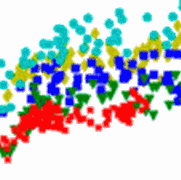


Bercem Dutagaci, Kitiyaporn Wittayanarakul, Takaharu Mori, Michael Feig
Journal of Chemical Theory and Computation (2017), 13, 3049-3059
A scoring protocol based on implicit membrane-based scoring functions and a new protocol for optimizing the positioning of proteins inside the membrane was evaluated for its capacity to discriminate native-like states from misfolded decoys. A decoy set previously established by the Baker lab (Proteins: Struct., Funct., Genet. 2006, 62, 1010–1025) was used along with a second set that was generated to cover higher resolution models. The Implicit Membrane Model 1 (IMM1), IMM1 model with CHARMM 36 parameters (IMM1-p36), generalized Born with simple switching (GBSW), and heterogeneous dielectric generalized Born versions 2 (HDGBv2) and 3 (HDGBv3) were tested along with the new HDGB van der Waals (HDGBvdW) model that adds implicit van der Waals contributions to the solvation free energy. For comparison, scores were also calculated with the distance-scaled finite ideal-gas reference (DFIRE) scoring function. Z-scores for native state discrimination, energy vs root-mean-square deviation (RMSD) correlations, and the ability to select the most native-like structures as top-scoring decoys were evaluated to assess the performance of the scoring functions. Ranking of the decoys in the Baker set that were relatively far from the native state was challenging and dominated largely by packing interactions that were captured best by DFIRE with less benefit of the implicit membrane-based models. Accounting for the membrane environment was much more important in the second decoy set where especially the HDGB-based scoring functions performed very well in ranking decoys and providing significant correlations between scores and RMSD, which shows promise for improving membrane protein structure prediction and refinement applications. The new membrane structure scoring protocol was implemented in the MEMScore web server (http://feiglab.org/memscore).